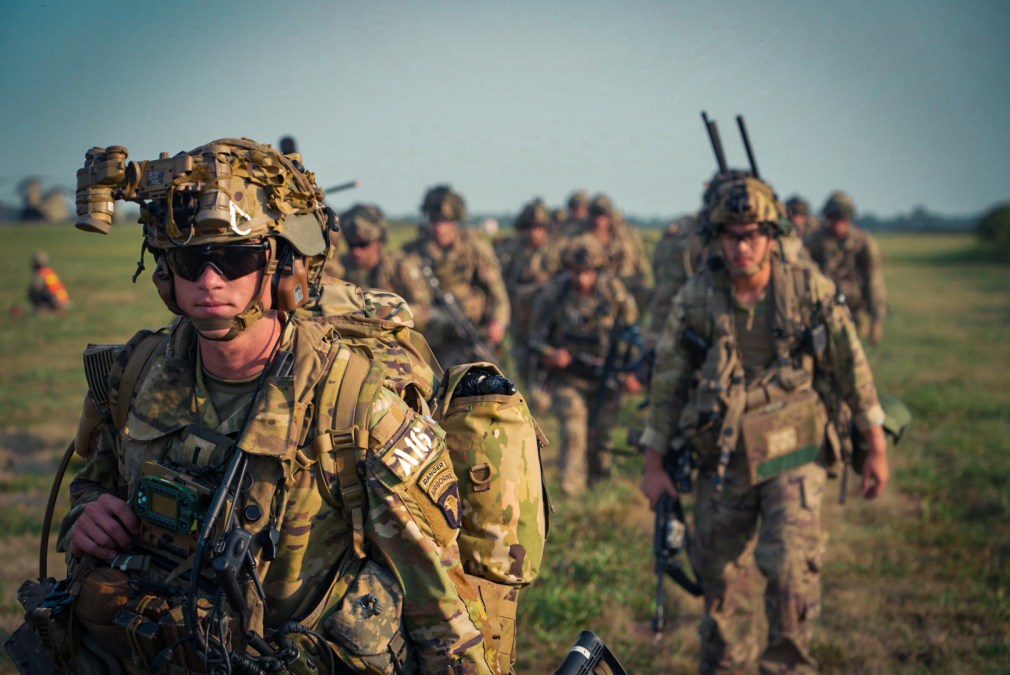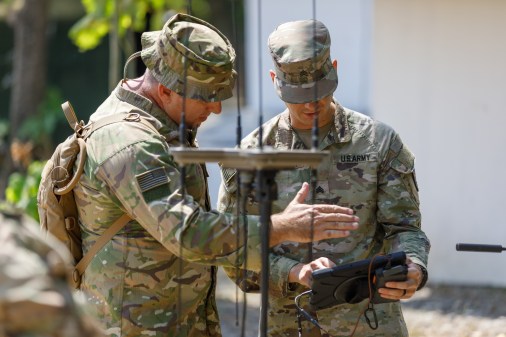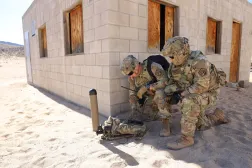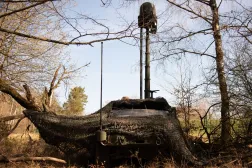Army office using ‘transforming in contact’ units to test new EW gear

The Army’s electronic warfare program office is using experimental units to help pave the way for its emerging capabilities and devise future requirements and concepts.
Those units are part of Chief of Staff Gen. Randy George’s so-called transforming-in-contact concept, where the service plans to use deployments and troop rotations to test new equipment — mainly commercial off-the-shelf gear — that could allow units to be more responsive on a dynamic battlefield.
According to George, there are three areas where the Army needs to be faster and more adaptable when it comes to delivering equipment to forces, due to how challenging the threat environment is and the cat-and-mouse aspect of countering opponents’ moves: unmanned aerial systems, counter-UAS and electronic warfare.
Those transforming-in-contact units include: 2nd Brigade, 101st Airborne Division — the first mobile brigade combat team — 3rd Brigade, 10th Mountain Division and 2nd Brigade, 25th Infantry Division.
Given the rate of change in the electromagnetic spectrum, enabled by software-defined systems that can be altered as fast as a patch is able to be developed and delivered, the Army wants to prioritize tools that can be fielded rapidly.
“My number one talking point in terms of our equipping for the future is our focus on doing limited prototyping and rapid fielding of mature [commercial-off-the-shelf/government-off-the-shelf] products,” Kenneth Strayer, project manager for electronic warfare and cyber at program executive office for intelligence, electronic warfare and sensors, said in an interview previewing his remarks that he’s slated to deliver Wednesday alongside the Army capability manager for EW at the TechNet Augusta conference.
“The pendulum consistently swings and we’re going back towards the need and the desire to get equipment, limited prototypes, in the hands of units very quickly so that they can learn, they can iterate, and we can get early, good enough capability out to the field,” he added. “We’re looking at off the shelf. We don’t want to do all the development in house. I don’t think we need to because there’s now a competitive marketplace out there to be able to buy ready products or things that need minor modification and integration. Long, long list of vendors who are offering some very effective capability for remote sensors and [software-defined radios] and digitization.”
Part of that change is necessitated by observations from Ukraine in which the cat-and-mouse game of systems being countered and counters being countered, are occurring in hours or days as opposed to the Cold War paradigm of weeks, months or years.
The Army is now trying to get out of the business of major programs that take years to develop through lengthy requirements, tweaks and user tests, shifting the way it talks about strategies and prioritization, but Strayer declined to quantify the ratio or percentage of commercial versus major government-run programs in the future. In some cases, though, these exquisite systems are necessary to build for specific needs.
One such system is the Multi-Function Electronic Warfare Air Large (MFEW) that serves as the Army’s only airborne electronic warfare (with limited cyber) capability organic to combat aviation brigades to support maneuver commanders on the ground. The Lockheed Martin-made technology is a pod-mounted capability on a MQ-1C Gray Eagle drone. It has been under development for roughly seven years.
“It’s not like I can go out and just go buy a pod that does this. It required a lot of detailed engineering and testing and packaging. That’s part of the reason why MFEW is taking perhaps longer than some people hope it would because there are problems out there that requires that level of engineering and acquisition,” Strayer said. “We would prefer, whenever possible, to not go down that pathway.”
Strayer said he’d like to get MFEW in the hands of a transforming-in-contact unit following the system’s limited user test next year, but that might be a ways off. Currently the program is getting ready to perform airworthiness certification on the Gray Eagle. Once that’s completed, officials will perform a developmental test at the beginning of next year with a limited user test at the end of the year. Pending the results of that, Strayer said he’d like to get the initial pods in the hands of a unit in 2026.
MFEW has done some support at Fort Drum, New York, with the 10th Mountain Division to demonstrate the payoff of having that high-capability airborne, long-range platform. There were favorable comments from the unit during their recent exercises, Strayer said.
One of the best examples of the new approach is the Terrestrial Layer System-Brigade Combat Team Manpack system, the first official program in decades for a dismounted electronic attack capability that soldiers can use to conduct jamming on-the-move as well as direction and signal finding with limited signals intelligence capabilities.
The system, made by Mastodon Design, a CACI subsidiary, was previously used by U.S. Special Operations Command, allowing the Army to shrink down the timeline for much of the necessary vetting and testing of a new program. The Army awarded Mastodon a nearly $100 million procurement and fielding contract earlier this year.
“It was a huge win for us. I mean, we went from good idea to a fielded product in about 24 months, which is unheard of in acquisition cycles. A lot of that’s because it was a mature baseline. We had a lot of tests and performance data, not only with Socom, but other services and units who had been buying this product over the last couple of years,” Strayer said. “Another good example of how [in] industry there’s now a very robust industry community who’s developing what I call off-the-shelf products that we view more as a catalog buy than a developmental program.”
Strayer said 2nd Brigade, 101st Airborne Division received some of these systems — albeit on loan — during its rotation at the Joint Readiness Training Center this month, to test the system and provide feedback.
Overall, the Manpack system received enough funding in the fiscal 2024 appropriation to purchase enough for two brigades. Pending the fiscal 2025 appropriation, the service will have enough for another eight brigades, with the eventual goal of total Army fielding.
In addition to the Manpack, 2nd Brigade, 101st is also experimenting with the Tactical Electronic Warfare System-Infantry (TEWS-I) at JRTC, a quick-reaction capability built a few years ago by General Dynamics, serving as a smaller system designed for infantry vehicles. While there won’t be any future production on that system given it was a quick-reaction capability, Strayer said it has generated discussion on requirements for light and airborne forces for mobility.
“Because it’s more tightly integrated into a platform, you get some of the advantages of the tactical mobility and the power that comes with that. We’re really interested in getting the feedback and seeing where we go,” he said. “If there is a requirement for this lightweight mobile kit, then we have to look at the payoff as to whether you need some of the more higher-end capability that comes on TEWS-I or if it’s really a Manpack, which is maybe up-gunned and more fully integrated into a vehicle platform. I think those are two different approaches you could take to the problem.”
Strayer noted that other transforming-in-contact units have begun to experiment with other capabilities, although he declined to specifically identify those units. One includes pre-prototypes of a Spectrum Situational Awareness System (S2AS), a new start in fiscal 2025 envisioned to be a commercial off-the-shelf solution that will provide sensing and visualization of what units look like in the spectrum and allow commanders to be able to sense and report in real-time their command post signature, sources of electromagnetic interference — either from coalition partners or the enemy — and what threat emissions look like.
The program office also hopes to get emerging systems into the hands of the these units. Those include the Electronic Warfare Planning and Management Tool (EWPMT) Next, a command-and-control planning capability that allows service members to visualize potential effects within the invisible spectrum and chart courses of action to prevent their forces and systems from being jammed during operations. The “Next” effort involves shifting to the Tactical Assault Kit framework, where applications for situational awareness data and geospatial visualizations can be created for better joint and coalition integration.
The emerging systems also include representative products associated with a new electronic warfare architecture the Army is developing, once established.






